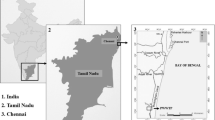Abstract
Previous whole animal bioassays with scrap tireleachates demonstrated an antagonistic interactionbetween salinity and toxicity, but it is unknown ifthe effect is due to an interaction between saltsand toxic mode of action, or release of toxicantsfrom the rubber matrix. Microtox® bacterialluminescence bioassays were performed on tireleachate solutions in a gradient of salinities from0 to 25 ppt to assess salt/toxicant interactions.Leachate solutions generated at specific salinitieswere amended to higher salinities to assess theeffect of sea salt on toxicity vsleachability/solubility of toxicants. Salineleachate solutions were also diluted with freshwaterleachate. Original leachates and samples amendedwith additional salt were aged for 8 days andretested to assess longer term interactions betweensalt and toxicants. The toxicity of leachatesdecreased with increasing salinity up to 15 ppt,with no significant change at higher salinities.Adding sea salt to leachate solutions did notimmediately decrease toxicity significantly, exceptfor samples starting at zero salinity. This wasinterpreted as an indication of interaction betweensea salt and the toxic constituent(s) in theleachate. Salinity decreases also indicated a directeffect of sea salt on toxicants. Ageing samplesindicated a long term interaction between sea saltand leachate toxicants, but not degradation, over atleast a two week period. Tire leachates are probablya greater threat to freshwater habitats thanbrackish or marine habitats, but bioaccumulation ofpersistent organic contaminants from tires is an unknown.
Similar content being viewed by others
Explore related subjects
Discover the latest articles, news and stories from top researchers in related subjects.References
Anthony, D. H. J. and Latawiec, A.: 1993, 'A Preliminary Chemical Examination of Hydrophobic Tire Leachate Components. Part III: Preliminary Chromatographic and FTIR/UV/VIS Spectrometric Examination of Major Tire Leachate Components', Environment Canada, National Water Research Institute, Research and Applications Branch, Analytical Chemistry Research Project, Burlington, Ontario. NWRI Contribution 93-76, 17 pp.
Anthony, D. H. J., Latawiec, A., Hartwell, S. I. and Jordahl, D. M.: 1996, 'A Spectrometric and Chromatographic Chemical Comparison of Solvent Extracts of Whole Tire Leachate and Shredded Tire Leachates Obtained at Varying Salinity', Environment Canada, National Water Research Institute, Research and Applications Branch, Analytical Chemistry Research Project, Burlington, Ontario. NWRI Contribution 95-112, 41 pp.
Azure: 1992, Microtox® Manual, Azure Corporation, Carlsbad, CA, 476 pp.
Brydson, J. A.: 1987, Rubber Chemistry, Applied Science Publishers, Ltd., London, 462 pp.
Candle, R. D.: 1985, 'Scrap Tires as Artificial Reefs', in D'Itri (ed.), Artificial Reefs, Marine and Freshwater Applications, Lewis publishers, Inc., Chelsea, MI., pp. 293–302.
CFR (Code of Federal Regulations): 1991, Toxicity Leachate Characterization Procedure (TCLP), Federal Register, Section 40, Part 261, Appendix II, July 1, 1991, Washington, DC.
Day, K. E., Holtze, K. E., Metcalfe-Smith, J. L., Bishop, C. T. and Dukta, B. J.: 1993, Chemosphere 27, 665.
Goudey, J. S. and Barton, B. A.: 1992, The Toxicity of Scrap Tire Materials to Aquatic Organisms, Report to Souris Basin Development Authority, Regina, Saskatchewan. Hydroqual Laboratories Limited and Environmental Management Associates, Calgary, Alberta, 21 pp.
Hartwell, S. I., Jordahl, D. M., Dawson, C. O. and Ives, A. S.: 1998, Trans. Am. Fish. Soc. 127, 796.
Johnson, D. L. and Stein, R. A.: 1979, Response of Fish to Habitat Structure in Standing Water, American Fisheries Society (North Central Division) Special Publication 6, Bethesda, MD, 77 pp.
Latawiec, A. P.: 1994, Spectroscopic Investigation Related to Tire Leachates, Report to Environment Canada, National Water Research Institute, Research and Applications Branch, Analytical Chemistry Research Project, Burlington, Ontario. DSS Contract KW405-3-0094, 34 pp.
McGuirrin J., Phillips, S., Stone, R., Vail, V., Meir, M. and Eklund, A. M.: 1988, A Profile of Atlantic Artificial Reef Development, Atlantic States Marine Fisheries Commission, Special Report 14, 169 pp.
Parker, R. O., Stone, R. B., Buchanan, C. C. and Steimle Jr., F. W.: 1974, Fishery Facts 10: How to Build Marine Artificial Reefs, U.S. Department of Commerce, National Oceanic and Atmospheric Administration, National Marine Fisheries Service Special Publication. Seattle, WA, 47 pp.
Peterson, J.C., Clark, D.F. and Sleevi, P.S.: 1986, Analytical Chemistry 58, 70A.
RWM (Rubber World Magazine): 1988, Rubber World Magazine's Blue Book, Lippincott & Peto. Publications, Philadelphia, PA.
Seaman,W. and Sprague, L.M. (eds.): 1991, Artificial Habitats forMarine and Freshwater Fisheries, Academic Press, Inc., New York, 285 pp.
Spies, R. B., Andersen, B. D. and Rice Jr., D. W.: 1987, Nature 327, 697.
Stone, R. B., Buchanan, C. C. and Steimle, F. W.: 1974, Scrap Tires as Artificial Reefs, U.S. Environmental Protection Agency, Washington, D.C., Environmental Protection Publication SW-119, 33 pp.
Author information
Authors and Affiliations
Corresponding author
Rights and permissions
About this article
Cite this article
Hartwell, S.I., Jordahl, D.M. & Dawson, C.E.O. The Effect of Salinity on Tire Leachate Toxicity. Water, Air, & Soil Pollution 121, 119–131 (2000). https://doi.org/10.1023/A:1005282201554
Issue Date:
DOI: https://doi.org/10.1023/A:1005282201554




